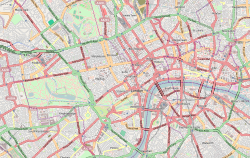This article needs additional citations for verification .(September 2021) |
 | |
| Dissolved | 2013 |
|---|---|
| Location | 64-66 Tooley Street, London SE1 2TF, England, UK |
| Coordinates | 51°30′21″N0°05′04″W / 51.505779°N 0.084356°W |
| Public transit access | London Bridge |
| Website | www.britainatwar.co.uk |

The Winston Churchill's Britain at War Experience was from 1992 to 2013 a themed museum located in central London, which recalled the London Blitz.
